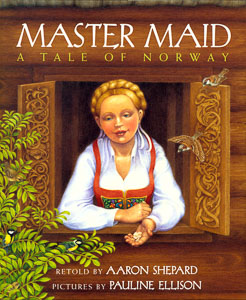In the author note to my picture book, I mentioned that this folktale is an example of “The Girl as Helper in the Hero’s Flight,” tale type #313 in the Aarne-Thompson index. Here is a further discussion of that tale type, taken from an earlier and longer version of my note.
The information comes mostly from The Folktale, by Stith Thompson, Holt, Rinehart and Winston, 1946, pages 87–90. The story section I mention in regard to the motif “The Forgotten Fiancée” was removed from the final version of my retelling, but can be found on my Web site as a deleted scene.
—Aaron
“The Girl as Helper” provides a good example of the mix-and-match construction of many folktales. It consists of several distinct sections, each built around a popular “motif.” Within this general structure lies the potential for great variety.
Any of several beginnings may be used. For instance, the story may start with the motif “The Swan Maiden,” in which the hero prevents an enchanted maiden from regaining her animal form until she promises to marry him. Other times, as in “Master Maid,” there is only minimal introduction. In my adaptation, I’ve chosen to add thematic material at this point.
In the next section, the villain sets three all-but-impossible tasks for the hero, who accomplishes them with the heroine’s help. This motif is often called “The Son-in-Law Tasks,” because in most versions the villain is the father of the heroine. (In “Master Maid,” the relationship between the troll and the girl is tantalizingly obscure.)
Next, the hero and the heroine flee, while blocking the villain’s path with three magical objects. This is “The Obstacle Flight.” Some versions instead use “The Transformation Flight,” in which the two evade capture by transforming themselves into pairs of objects—for example, a thorny hedge and a rose. In “Master Maid,” The Obstacle Flight is abbreviated to one obstacle, but I have filled out this portion with two other common ones.
Finally comes the “The Forgotten Fiancée” motif. The hero breaks a taboo and forgets the heroine, who then restores his memory in any of a number of ways. Historically, this motif is a late addition, so not all versions include it. In “Master Maid,” though, this section is particularly long and complex. For my adaptation, I have shortened and simplified it considerably, bringing it more in line with how it appears in other versions. I have also borrowed from another version a more logical and satisfying device for the final jogging of the prince’s memory.
